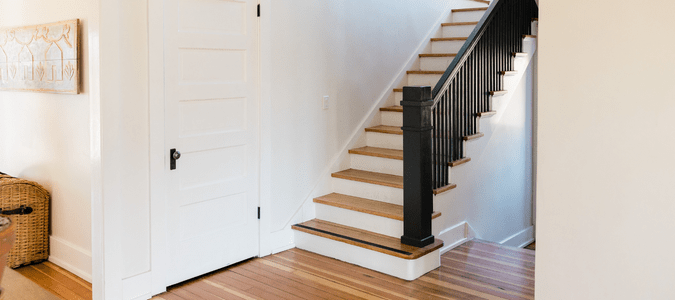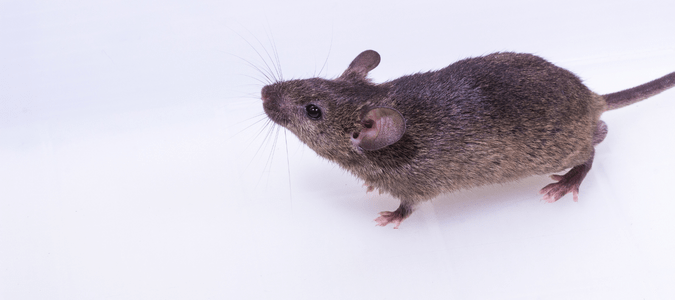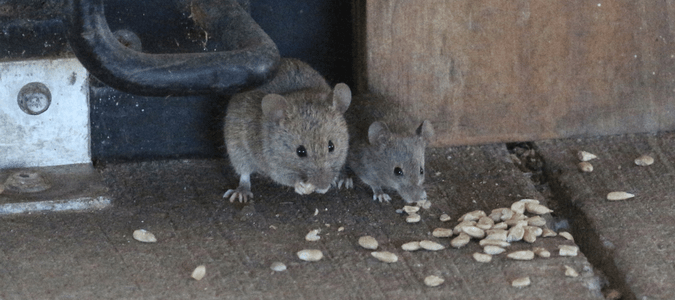Are you hearing the sound of mice scurrying through your walls at night? Mice are excellent climbers, so it’s natural for homeowners to wonder: Do mice usually go upstairs?
While mice can easily climb and jump their way to tall heights, it’s important to understand their habits and why they might be motivated to go to the upper stories of your home. It’s additionally important to know the habits, appearance and diet of brown mice so that you can deal with a house mouse infestation right away.
Finally, this guide will walk you through how to mouse-proof your house. Keep in mind that the best way to deal with mice is to enlist the help of a pest control specialist.
Do Mice Usually Go Upstairs?
Mice are excellent runners, climbers and jumpers, so they can easily go upstairs in a home. In fact, mice can jump as high as one foot, which is nearly twice the height of an average stair step. These unwanted house guests can also climb to the upper stories of your home through your walls.
Walls made of materials they can grip onto, such as bricks, make it even easier for mice to climb to high heights. They also scurry through air ducts and can climb up sheetrock and wood beams.
While mice can easily get upstairs, it’s important to remember their habits. The reason that mice enter your home in the first place is to find food and shelter. They build their nests close to their food source so that they don’t have to travel far and expose themselves to predators.
If you own a traditional multi-story home with a kitchen on the first floor, a mouse population would not have a good reason to go upstairs. Once the mice build their nest, they spend the days sleeping and the evenings running back and forth from their shelter to their food source.
The most common places for a mice to nest in your kitchen is behind appliances, in your cabinets and inside unused and cluttered drawers.
The only reason why mice would move throughout other areas of your home is to look for nesting materials. They like to build their nests out of fibrous materials such as string, fabric, paper and pillow stuffing.
If mice can’t find proper nesting materials on your first floor, they may venture to the second floor. Again, they will try to find nesting materials near their food source first. Mice are skilled survivalists and don’t like to travel too far to risk being exposed to predators.
If you suspect mice have taken up residence in your home, contact a pest control expert for the most efficient plan to get rid of these pests.
What is a Brown Mouse?
If you are seeing brown mice in your home, they are likely house mice. When dealing with a house mouse infestation, it’s important to understand their appearance, habits and diet.
Although their fur looks brown from a distance, house mice actually have light brown to dusty gray fur. They often have cream or sand-colored underbellies. Their bodies are round in shape, but house mice are slender overall. They measure between two and a half to four inches long.
House mice have long tails that add an additional two and a half to four inches to their overall length. Their tails are thin and scaly and do not have hair on them. House mice have pointed noses and large ears that have little bits of hair on them. Their eyes are small and black, but they stick out from their face.
What Do House Mice Eat?
House mice are not picky eaters and eat whatever they can get their paws on. However, if they had the choice, they would choose to eat grains, seeds, nuts, fruit, vegetables and cereal for every meal.
While these mice prefer to eat a vegetarian diet, they are omnivores. They will also eat meat, cheese, eggs and other dairy products if it is available to them. It is a myth that mice love cheese as they would much prefer other food choices.
Plants, soil, insects, pet food and other organic matter are also not out of the question in the diet of a house mouse. However, house mice enjoy living indoors because they can access the food they prefer, such as grains and seeds.
House mice are scavengers and are not afraid to dig for their food. They will rummage through your trash and compost bins to get to their meal. They can also easily eat through paper and soft plastic and will tear your pantry apart to access food.
What Are The Habits of House Mice?
House mice have short lifespans and live for less than a year. However, during that time they are rapid breeders. A female house mouse can reproduce between five to ten times a year, and each litter can have up to 12 pups.
Female house mice reach sexual maturity and can start reproducing when they are only one month old. After giving birth, they can get pregnant again in 60 days.
Besides breeding, house mice spend their days sleeping and staying safe in their shelter. They wake up at dusk and begin scurrying through your home to find their food.
These mice like to hoard food to help them feel secure, so they spend their waking hours running back and forth between their shelter and their food source. At dawn, mice go back to sleep.
When house mice first enter your home, they will also spend their waking hours building their nests. As mentioned above, they like soft and fibrous materials that they can hide in. They choose a nesting spot that is completely concealed to stay safe from predators.
House mouse colonies build their nests in two different ways. They either form all of their gathered materials into a tight ball or spread the materials out in a messy heap. They often hide food and leave droppings in their nests, which creates an unpleasant mess.
When house mice are first born, they spend a few weeks hiding in their nests until they reach maturity. Then, they join the rest of the house mouse population in scavenging for food. House mice are hard to eliminate because they are such prolific breeders. Contact a rodent control specialist to help you control your mouse problem.
How to Mouse-Proof Your House
The best way to deal with a house mouse population is to prevent them from entering your home in the first place. Follow the tips below to learn how to repel mice.
First, block off all easy entry points that mice could use to get inside your house. Inspect your home for tiny holes and cracks and repair them.
Next, remove their access to nesting materials. Store all linens, paper, string and other fibrous materials in metal containers that mice cannot chew through. Keep your garage, attic, pantry, kitchen cabinets and drawers clear of clutter.
It’s also crucial that you remove their food source. Keep a tight lid on your garbage and compost bins and don’t leave dishes with food on them in the sink overnight. Store your dry goods in hard plastic or metal containers that they cannot eat their way through.
Do not leave fruit out on your counters. If you have pets, only put out their food during meal times and take it up when they are done.
You should also eliminate their water sources. Check your home for sweaty pipes, open drains or leaky taps. Keep in mind that these prevention methods only work after you’ve eliminated your house mouse colony. For a comprehensive rodent prevention plan, contact a pest control specialist.
How To Get Rid of House Mice
The best way to get rid of mice is to work with a pest control expert. They have the training and the tools necessary to control a population of rodents. However, you can do your part by following the tips above and removing access to food and water. Making your home and kitchen inhospitable to mice will be extremely helpful in your mouse control efforts.
Kick Mice Out of Your Home
House mice can easily get upstairs, but it is unlikely that they will try if they have access to everything they need on your first floor. Now that you know the habits and abilities of mice, you can make your home less attractive to them. However, if you already have house mice in your home, you must get rid of them first.
ABC Can Help Get Rid of Mice
Dealing with a house mouse infestation can be overwhelming, especially if you catch it too late. Contact our rodent control specialists at ABC Home & Commercial Services as soon as you notice signs of mice in your home. We have the tools and expertise to locate where mice are getting into the house, seal off these areas and implement an effective pest control plan.



